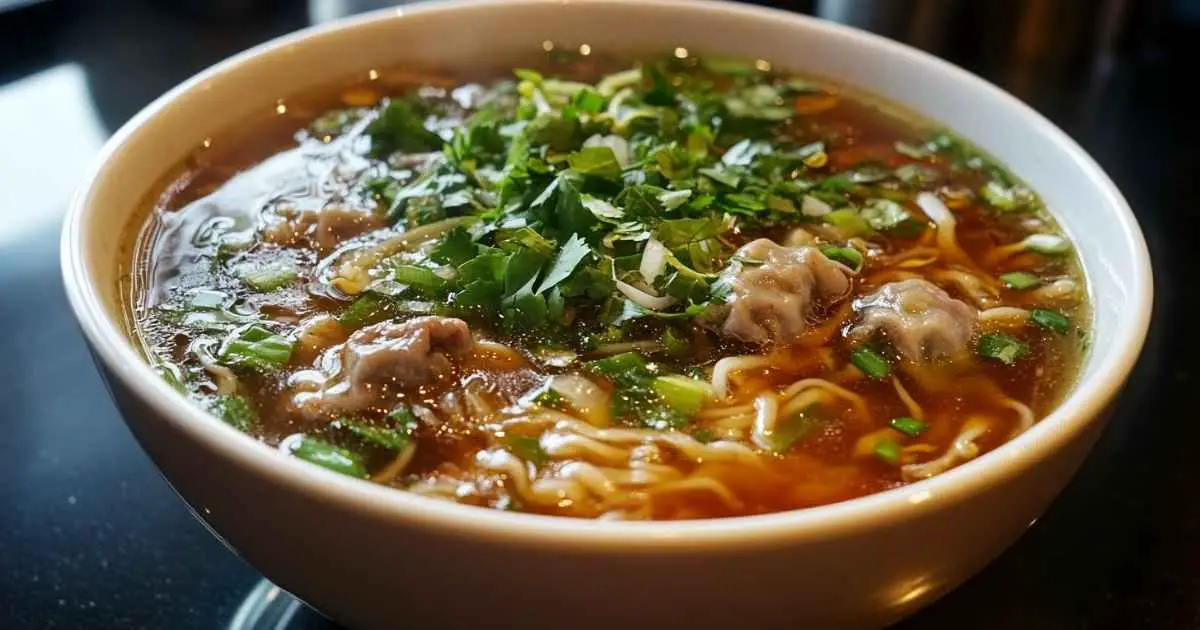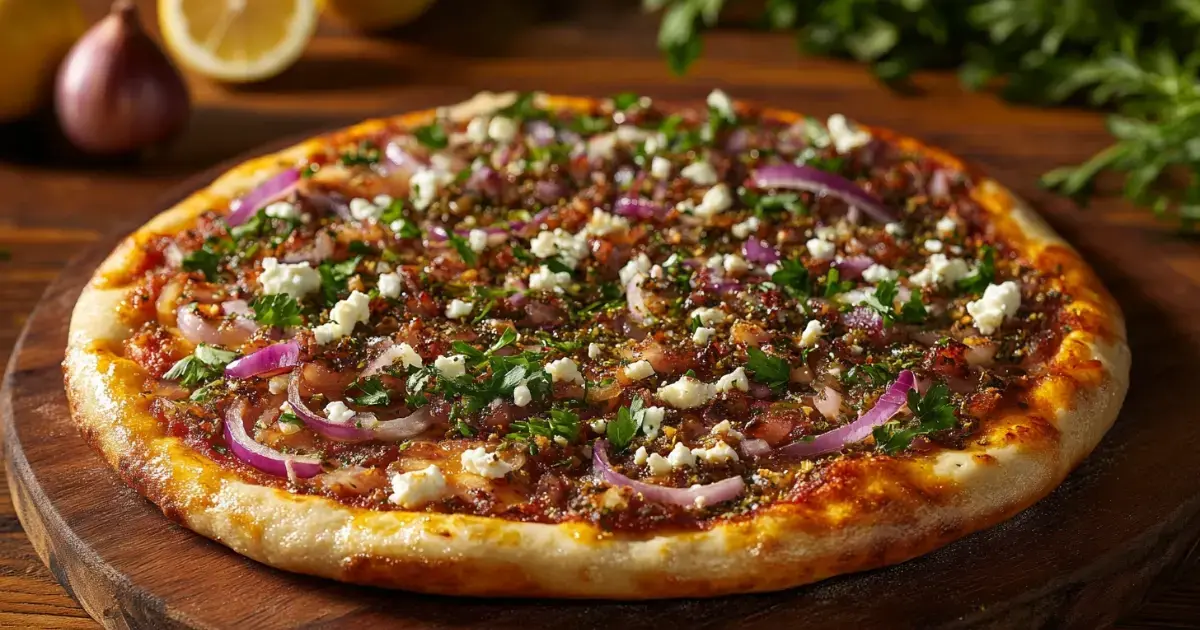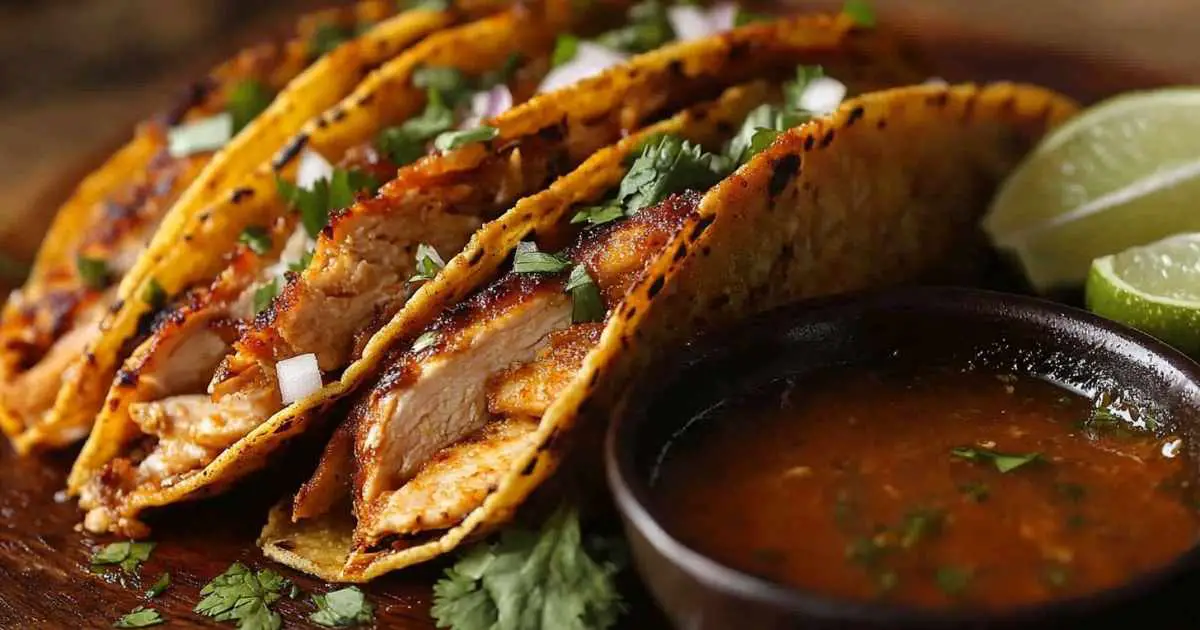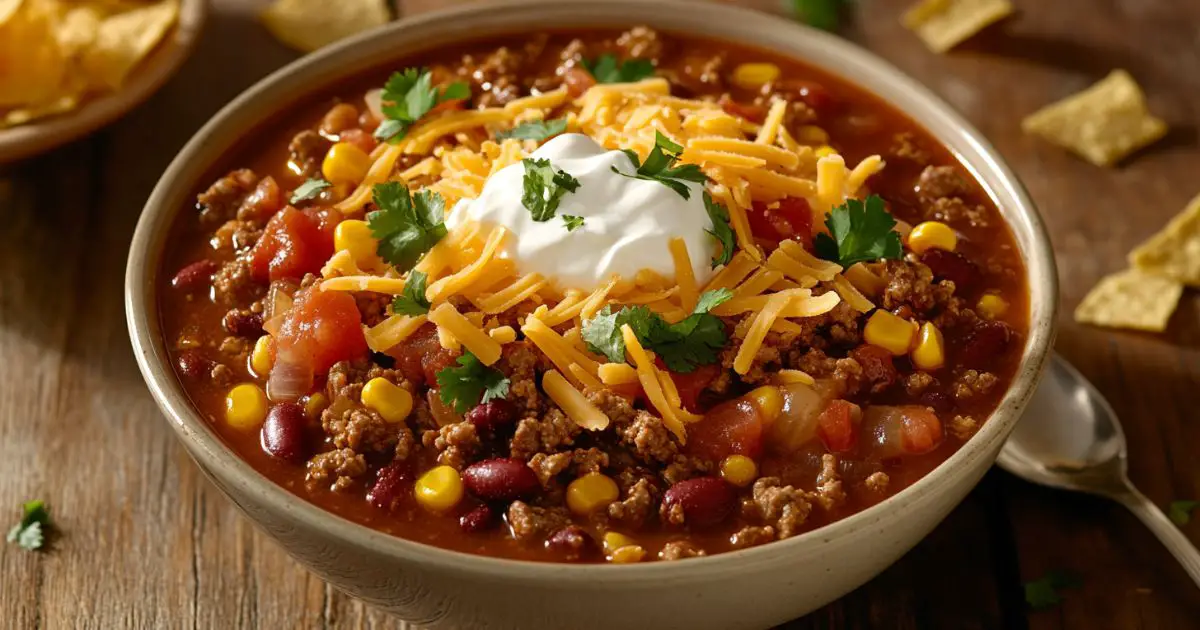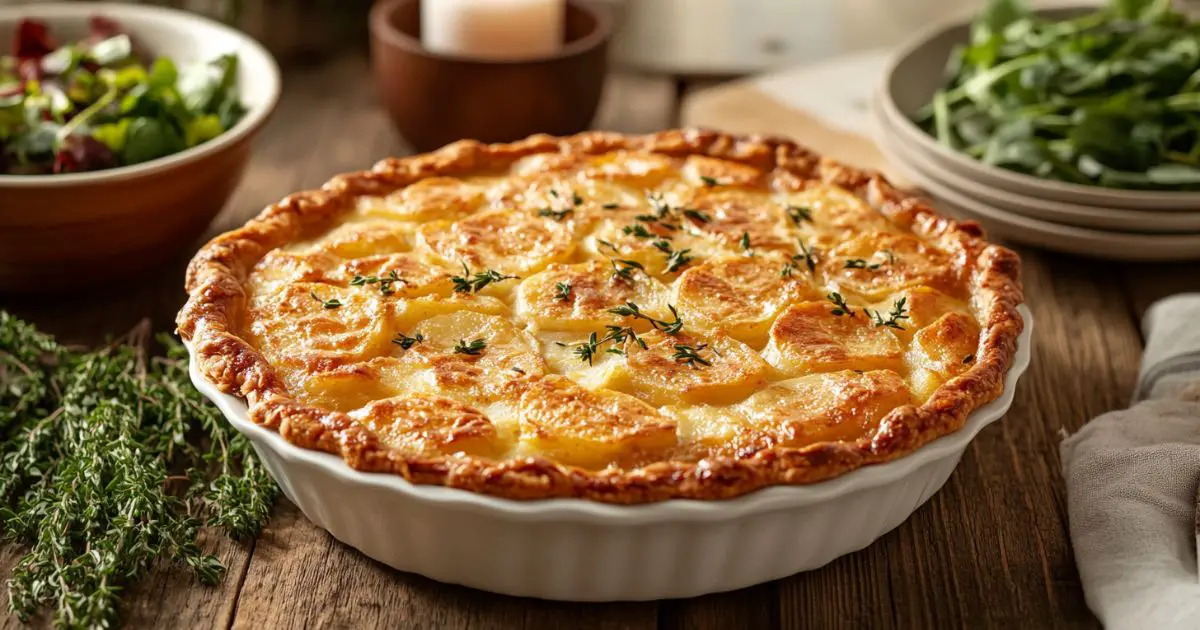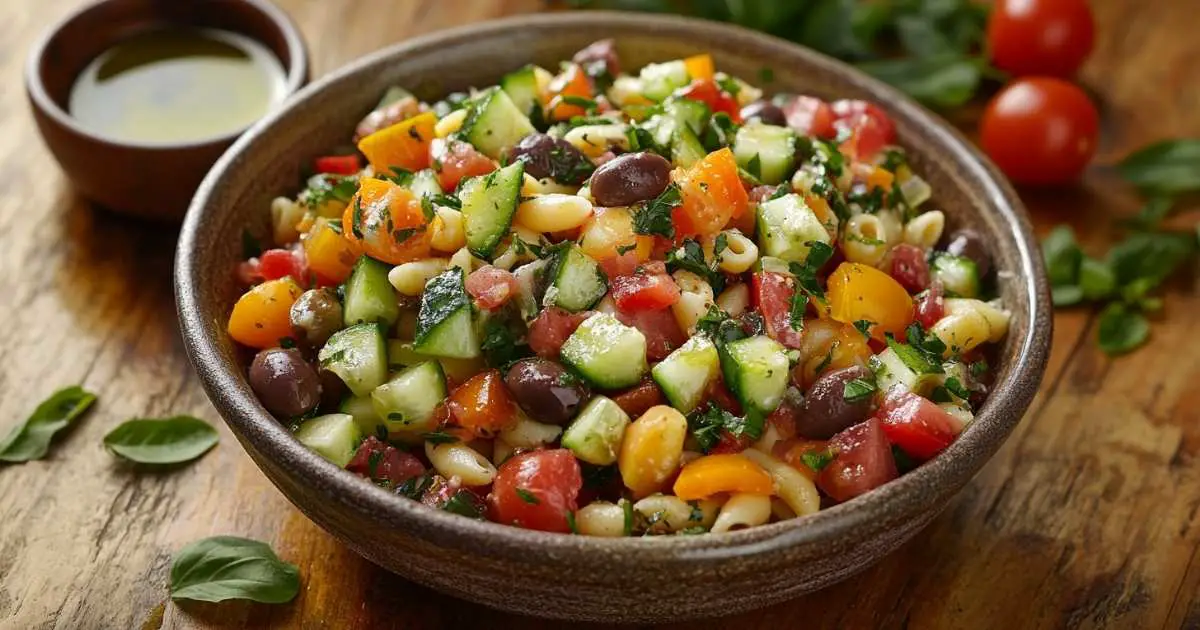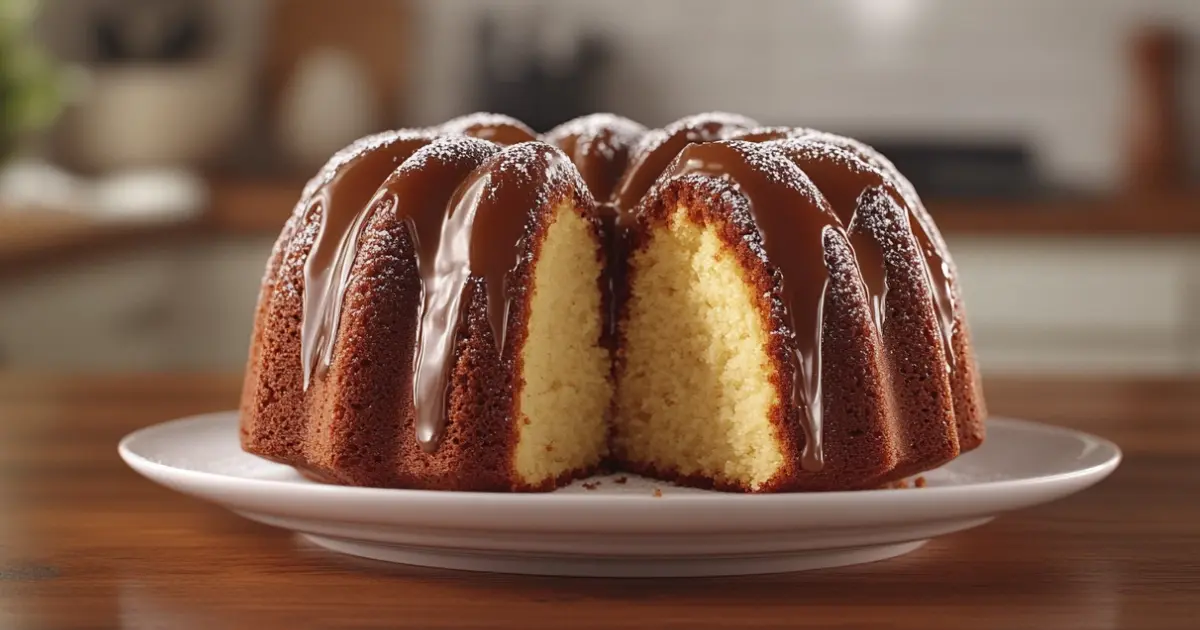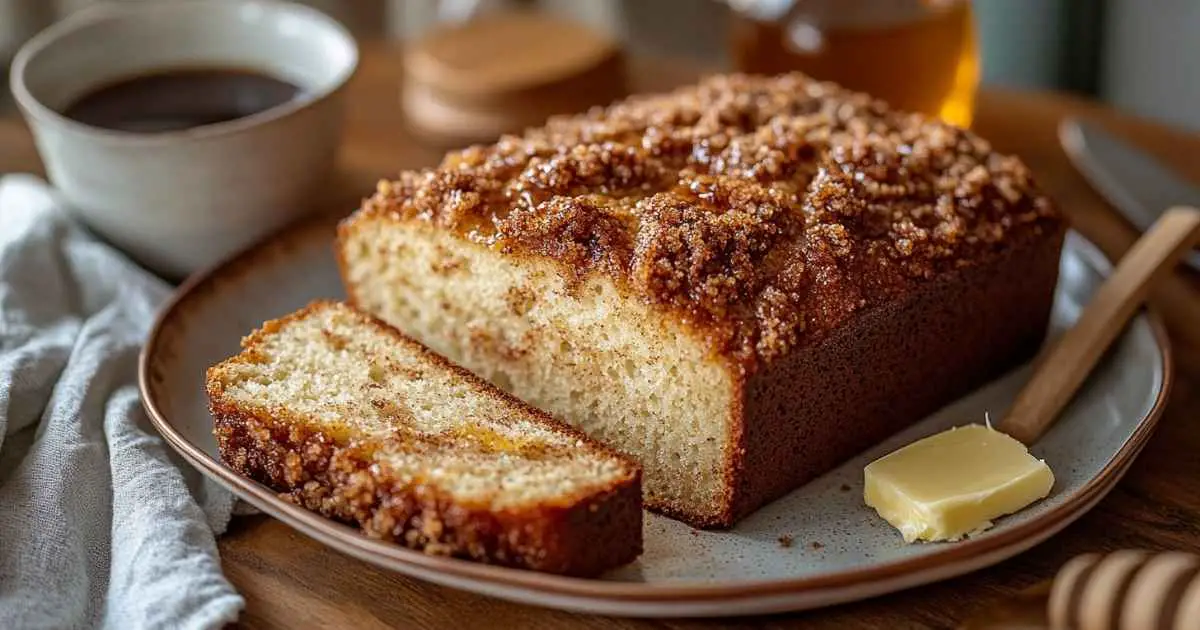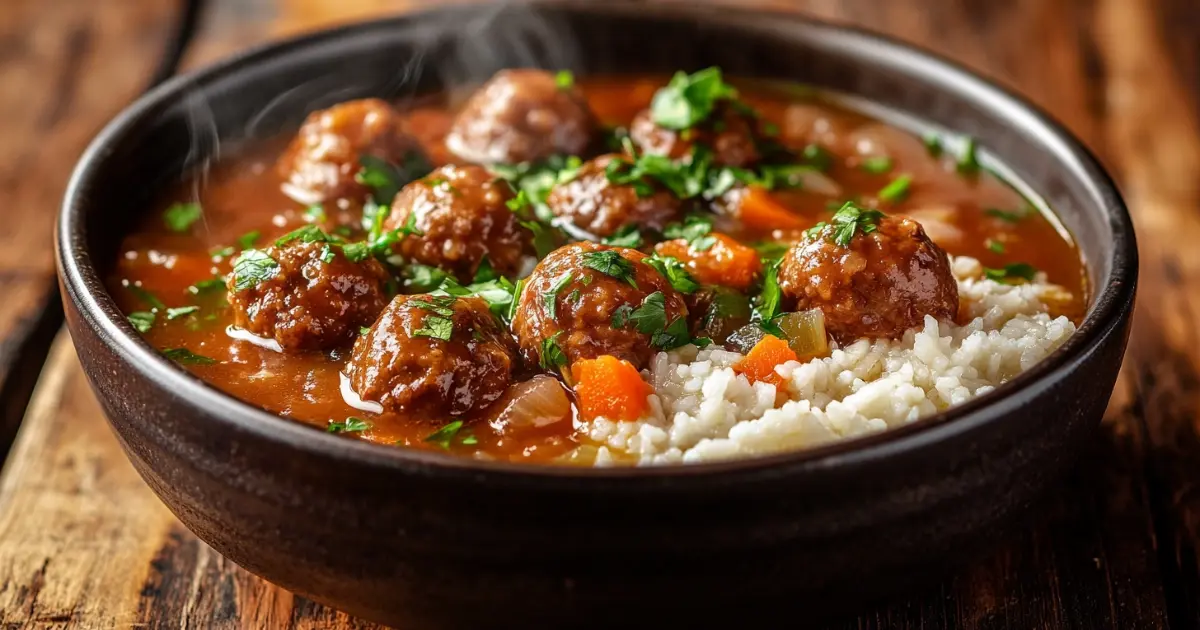Wonton noodle soup is a comforting dish that brings warmth and satisfaction. Each bowl features smooth noodles, bite-sized wontons, and a savory broth that teases the senses. This soup has long been a favorite in many regions due to its welcoming taste and pleasing texture. People often enjoy it for family dinners or casual get-togethers with friends. The balanced mix of fresh ingredients, gentle spices, and tender dumplings satisfies a craving for something wholesome.
You will discover that wonton noodle soup can be adapted in various ways. The wontons can contain shrimp, chicken, or a blend of vegetables. The broth can also be rich or light, depending on your preference. In this guide, you will learn how to make wonton noodle soup at home step by step. Get ready for a friendly walkthrough that delivers a piping-hot bowl of simple comfort.
Why You’ll Love This Recipe
You will love this recipe because it gives you a simple way to enjoy homemade wonton noodle soup without fuss. The harmony of chewy noodles and delicate wontons offers a textural treat. The soup base highlights fresh ingredients like ginger, green onion, and chicken broth, which helps form a calm, soothing taste. This dish also gives you the chance to adjust the flavor based on your liking. Want a little spicy kick? Add chili oil or hot peppers. Prefer a milder profile? Keep things gentle with basic seasoning.
Another reason to love this easy wonton noodle soup is the freedom it provides. If you dislike store-bought choices, homemade wontons and noodles let you pick quality ingredients, ensuring a fresher soup. You can also make extra wontons and freeze them for later, cutting down on prep time for busy days. Once you learn how to fold these dumplings, the rest becomes straightforward.
This comforting recipe also adds a sense of fun in the kitchen. Folding wontons can bring family or friends together, making your cooking time feel special. Enjoy the aroma as the broth simmers, and experience that feeling of warmth when you finally tuck into a bowl of hot noodle soup.
Ingredients
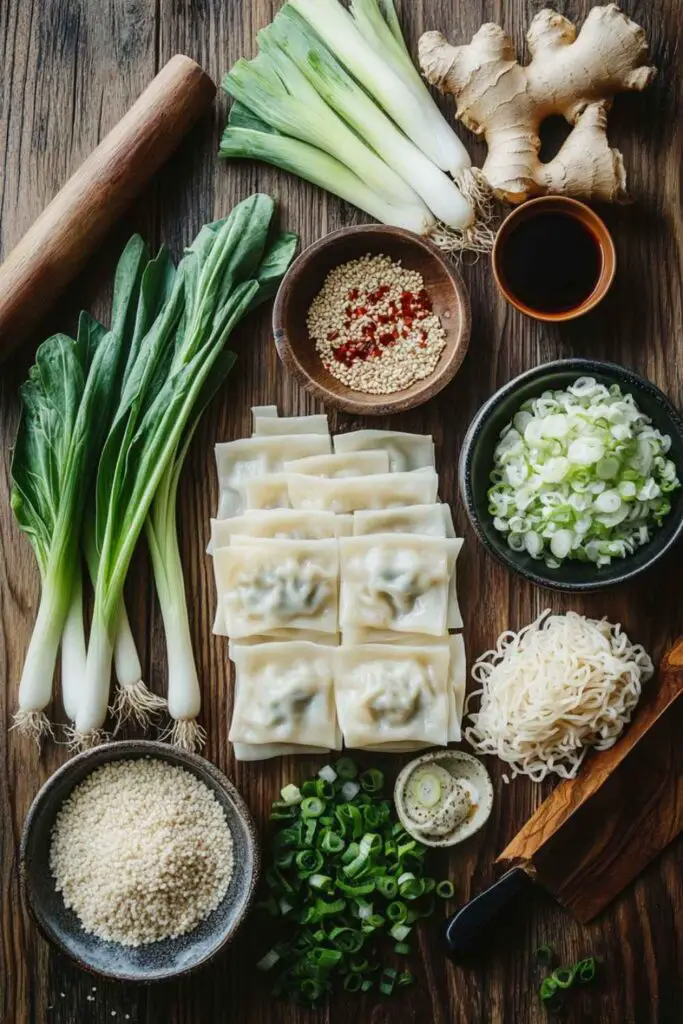
Below is a detailed list of what you need to create a flavorful wonton noodle soup at home. You can swap certain items if they are hard to find, but aim to keep the key components for the right taste. These ingredients align with a classic Cantonese wonton noodle soup style while allowing for personal preferences. Feel free to make adjustments based on availability or dietary needs.
- Wonton Wrappers
- Look for square or round wonton wrappers in the refrigerated section of many grocery stores or at an Asian market. You may see them labeled as dumpling wrappers or wonton skins. They are thin sheets of dough used to enclose the wonton filling.
- Wonton Filling
- Shrimp (8 to 12 ounces, peeled and deveined): Fresh shrimp bring a light ocean taste to the filling. Chop them into small pieces to allow for even cooking.
- Ground Chicken (optional): Some recipes include ground chicken for added texture. If you prefer a shrimp-only filling, leave out the chicken.
- Green Onions (2 to 3 stalks, chopped): Fresh green onions enhance the flavor of the wontons and the soup.
- Ginger (1 teaspoon, grated or finely minced): Adds a gentle zing that complements the shrimp.
- Soy Sauce (1 tablespoon): A staple seasoning that adds depth.
- Sesame Oil (½ teaspoon): Contributes a warm aroma and a hint of nuttiness.
- Broth
- Chicken Stock or Chicken Broth (6 to 8 cups): Acts as the base for the soup. A good-quality chicken broth influences the final taste in a big way. You can also use a homemade chicken broth if you have it on hand.
- Ginger (2 to 3 slices, about the size of a quarter each): Fresh slices release a gentle warmth into the broth as it simmers.
- Green Onions (1 to 2 stalks, roughly chopped): Adds freshness.
- Soy Sauce (1 to 2 tablespoons): Adjust to taste, depending on how salty the stock is.
- Sesame Oil (1 teaspoon): A small drizzle gives the soup a pleasing aroma.
- Salt and Pepper (to taste): Helps balance the flavors in the final broth.
- Noodles
- Egg Noodles (fresh or dried): Look for wonton noodles, thin egg noodles, or another type of Chinese noodle. These noodles have a springy texture that works well in this soup. Fresh wonton noodles often cook faster than dried ones.
- Optional Extras
- Bok Choy or Choy Sum (1 to 2 bundles, chopped): Common in many versions of wonton noodle soup. You can blanch these greens to keep their bright color and fresh taste.
- Green Onions (sliced): Sprinkled on top as a garnish.
- Fresh Ginger (julienned): Can be used as a garnish for extra zing.
- Chili Oil or Chili Paste: For those who want a spicy kick.
- Additional Soy Sauce or Sesame Oil: For finishing, if you like stronger seasoning.
Each of these ingredients plays a part in making the best wonton noodle soup. Shrimp and optional ground chicken create a meaty wonton filling. Fresh vegetables, aromatic spices, and high-quality chicken broth combine to form a comforting base. The noodles add substance, making this dish a complete meal.
How to Make Wonton Noodle Soup Recipe
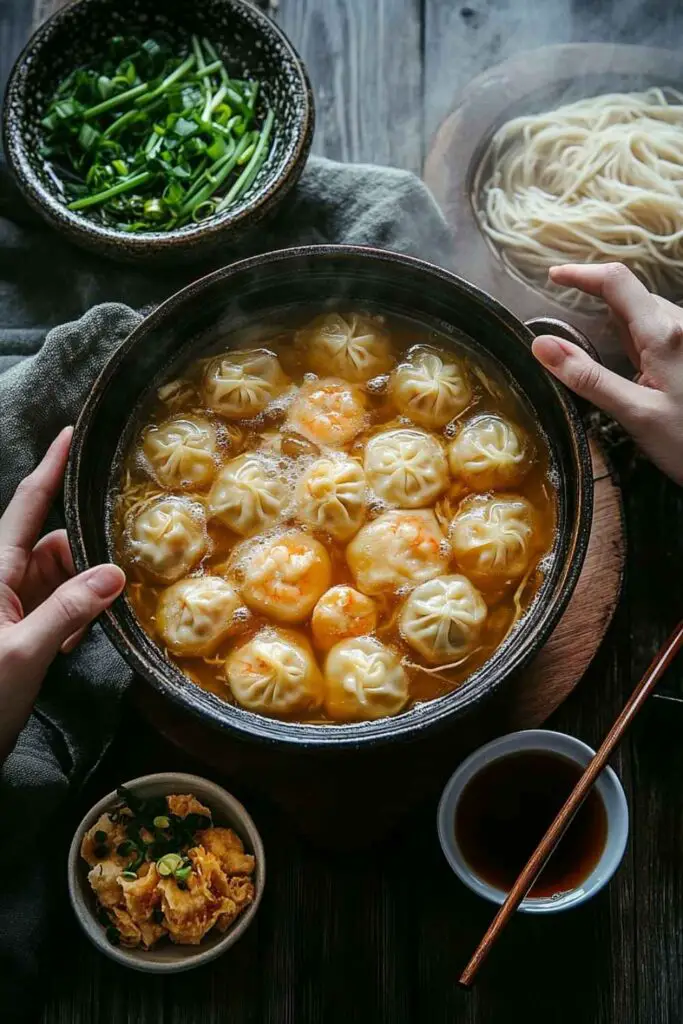
Follow these steps to create a satisfying bowl of easy wonton noodle soup. This method provides a clear path from start to finish. You can cook the wontons and noodles separately, then combine them in a large pot with hot broth.
- Prepare the Wonton Filling
- In a mixing bowl, place chopped shrimp (and ground chicken if desired).
- Add the chopped green onions, grated ginger, soy sauce, and sesame oil.
- Use a spoon or your hands to blend the mixture until it forms a consistent filling.
- Taste a small portion by pan-frying a teaspoon of the mixture in a skillet, then adjust seasoning if needed. This step helps ensure your final wontons have a pleasant flavor.
- Wrap the Wontons
- Take one wonton wrapper and lay it flat in your palm or on a clean surface.
- Place a small spoonful of the filling in the center. Avoid overfilling to prevent breakage while cooking.
- Moisten the edges of the wrapper with water using a fingertip or a brush.
- Fold the wrapper in half diagonally to form a triangle. Press the edges to seal.
- You can leave the wonton as is or bring the corners together to form a more traditional shape.
- Repeat this process until all the filling is used. You may end up with extra wrappers or extra filling. Store leftover wrappers in an airtight container in the refrigerator, or freeze leftover filling for later use.
- Set Up the Broth
- In a large pot, pour in the chicken broth or chicken stock.
- Drop the ginger slices and roughly chopped green onions into the pot.
- Add 1 to 2 tablespoons of soy sauce, then stir.
- Bring the broth to a gentle boil over medium-high heat. Lower the heat to let it simmer.
- Pour in the sesame oil, then taste the soup. If it needs more flavor, add a dash of soy sauce or a pinch of salt and pepper.
- Boil the Wontons
- In another pot, bring water to a boil.
- Drop the wrapped wontons into the boiling water in batches. This step helps keep the broth clear.
- Cook the wontons for about 4 to 6 minutes, or until they float to the surface. The internal filling should be fully cooked.
- Transfer the cooked wontons to a plate or directly into the simmering chicken broth if you prefer. If you are cooking them in batches, keep the wontons from sticking to each other by placing them on a lightly greased tray or adding a small amount of sesame oil to prevent them from drying out.
- Cook the Noodles
- If using fresh wonton noodles or egg noodles, bring a new pot of water to a rolling boil.
- Cook the noodles according to the package instructions. Fresh noodles may take 2 to 3 minutes, while dried ones can take 5 to 8 minutes.
- Drain the noodles in a colander, then rinse them under cool water to stop the cooking process. This also helps remove excess starch.
- Set the noodles aside until you are ready to assemble the soup.
- Assemble the Soup
- Check the flavor of your broth one more time. Adjust with salt, pepper, or soy sauce if needed.
- Place a portion of noodles in each serving bowl.
- Ladle some of the hot broth over the noodles.
- Add several cooked wontons on top.
- If using bok choy or choy sum, you can blanch or quickly boil it in salted water, then place it alongside the noodles.
- Garnish with sliced green onions or fresh ginger if desired. A quick drizzle of sesame oil or a sprinkle of chili oil can also liven up the flavor.
- Taste and Enjoy
- Taste the soup again to see if it matches your preference.
- Serve hot. A bowl of freshly made wonton noodle soup is best enjoyed right away.
- Provide additional condiments like soy sauce, chili oil, and sliced chilies at the table for those who want to adjust the flavor.
These steps offer a clear method to make your own homemade wontons, cook the noodles, and create a tasty broth. The result is a balanced soup brimming with the warmth of ginger, the savoriness of chicken broth, and the tenderness of shrimp-filled wontons.
Serving and Storage Tips
Serving wonton noodle soup in deep bowls helps keep everything warm. Ladle the steaming broth on top of your cooked noodles, then arrange wontons so they stay at the center. This presentation lets you see the colorful noodles, bright greens, and plump dumplings, which can spark your appetite. You can garnish each bowl with fresh green onion slices. A few drops of sesame oil or chili oil create an appealing aroma that draws people in. A side of pickled vegetables or a small plate of stir-fried bok choy also pairs well with the soup, rounding out the meal.
Storage becomes handy if you plan to enjoy leftover wonton noodle soup later. However, it is best to store each component separately to keep the noodles from becoming soggy. Place the broth in a sealed container and refrigerate it for up to three days. For the wontons, store them after boiling if they are already cooked. They can last in the refrigerator for a couple of days, or freeze them if you want them to stay fresh longer. Wontons freeze well. Lay them flat on a tray until they are firm, then transfer them to a freezer-safe bag or airtight container.
Cooked noodles can be kept in a container in the fridge for up to two days. If you plan to store them longer, consider freezing them to preserve the texture.
When reheating, simmer the broth in a pot over medium heat. If your wontons are frozen, boil them in water or stock until they float and the filling is fully cooked. Then add them to the heated broth. If your noodles are refrigerated, plunge them in boiling water for a few seconds to revive their springy bite before adding them to your soup. By keeping everything separate, you can enjoy a fresh-tasting bowl of hot wonton noodle soup even days after your initial cooking session.
This chart offers detailed recommendations for refrigerator and freezer storage durations to maintain food quality and safety: Cold Food Storage Chart
Helpful Notes
- Filling Choices: If shrimp is not your favorite, you can use only ground chicken or diced fish. You can even try a vegetarian mix of finely chopped mushrooms, spinach, or tofu for a meatless version. Experiment to see which flavors you prefer.
- Broth Tips: Homemade chicken broth often tastes cleaner and has less sodium than store-bought stock. If you have time, prepare a pot of broth with chicken bones, onion, ginger, and other aromatics. This extra step can give your wonton noodle soup a brighter flavor.
- Seasoning Caution: Soy sauce varies in saltiness. Start by adding a small amount, then taste the broth. Adjust with more soy sauce, salt, or sesame oil based on what you prefer.
- Noodle Selection: Not all noodles cook at the same rate. Check the instructions on the package. Fresh wonton noodles cook faster than dried ones, so keep a close watch to avoid overcooking them. If you cannot find wonton noodles, thin egg noodles are a decent substitute.
- Wonton Folding Technique: Folding wontons may be the trickiest part. Begin with a simple half-fold, then pinch the edges firmly. Use just enough water to moisten the edges. Too much moisture can make the wrappers soggy, while too little will stop the edges from sealing properly.
- Avoid Overstuffing: Large amounts of filling can tear the wrapper. It also affects cooking time, leading to unevenly cooked wontons. A teaspoon of filling is generally enough for each wrapper.
- Freezing Wontons: If you want to freeze raw wontons, place them on a parchment-lined tray. Once they become firm, store them in an airtight container. They can last in the freezer for up to two months. When cooking frozen wontons, drop them directly into boiling water or broth. Add a minute or two to the usual cooking time.
- Blanching Greens: Bok choy or other greens can bring brightness to your soup. To keep their color, boil them briefly in salted water, then plunge them into an ice bath. This locks in the vibrant hue and crisp texture.
- Garnish Ideas: Fresh cilantro, thinly sliced red chili, or toasted garlic bits can offer extra color and flavor. A splash of chili oil on top can also add some heat if you prefer spicy dishes.
Conclusion
A bowl of hot wonton noodle soup is more than a meal. It is a comforting fixture that calls to mind a sense of warmth and familiarity. The clear chicken broth, tender noodles, and small dumplings create a balanced harmony. The blend of ginger, sesame oil, and soy sauce adds depth without overpowering the core ingredients. This kind of soup can be a quick meal on a busy day or a special dish you prepare for loved ones.
You also gain the freedom to adjust the flavors and textures as you see fit. For some, a mild bowl is enough. Others may prefer an extra shot of chili oil to awaken the senses. You can swap out proteins, or fill your wontons with veggies for a different spin. The steps outlined here guide you from basic preparation to final assembly, ensuring that everything comes together in a smooth fashion.
Whether you are a fan of classic Cantonese wonton noodle soup or a newcomer eager to explore new recipes, this guide gives you the know-how to create something delightful. The advantage of homemade wontons and noodles lies in picking each ingredient and controlling the taste. Share this dish with friends or enjoy it alone. Either way, you will find yourself coming back to it whenever you want a cozy, filling meal. Wonton noodle soup proves that comfort can come from simple elements, joined in a single bowl.
_________________________________
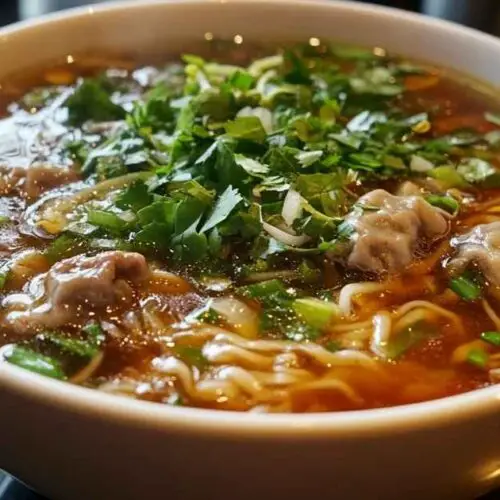
Wonton Noodle Soup Recipe
Ingredients
Wonton Wrappers & Filling:
- 12 oz shrimp peeled & chopped
- ½ lb ground chicken optional
- 3 stalks green onions chopped
- 1 tsp grated ginger
- 1 tbsp soy sauce
- ½ tsp sesame oil
- 24 wonton wrappers
Broth:
- 6 –8 cups chicken broth
- 3 slices ginger
- 2 stalks green onions chopped
- 1 –2 tbsp soy sauce
- 1 tsp sesame oil
- Salt & pepper to taste
Noodles & Garnish:
- 8 oz egg noodles fresh or dried
- 2 bundles bok choy optional
- Chopped green onions
- Julienned fresh ginger
- Chili oil or chili paste optional
Instructions
1. Prepare the Wonton Filling:
- In a bowl, mix shrimp, ground chicken, green onions, ginger, soy sauce, and sesame oil.
- Stir until well combined.
2. Wrap the Wontons:
- Place a teaspoon of filling in the center of a wonton wrapper.
- Wet the edges with water, fold into a triangle, and press to seal.
- Bring the two corners together to form a classic wonton shape.
- Repeat until all filling is used.
3. Make the Broth:
- In a large pot, add chicken broth, ginger slices, and green onions.
- Stir in soy sauce and sesame oil.
- Bring to a simmer over medium heat.
4. Boil the Wontons:
- In a separate pot, bring water to a boil.
- Add wontons and cook for 4–6 minutes, or until they float.
- Remove with a slotted spoon.
5. Cook the Noodles:
- In another pot, boil water and cook egg noodles according to package instructions.
- Drain and rinse with cool water.
6. Assemble the Soup:
- Divide noodles into bowls.
- Ladle hot broth over the noodles.
- Add cooked wontons.
- Garnish with green onions, fresh ginger, and chili oil if desired.
7. Serve & Enjoy:
- Taste and adjust seasoning if needed.
- Serve immediately for the best flavor!
Video
Notes
- Calories: 350 kcal
- Total Fat: 8g
- Saturated Fat: 2g
- Cholesterol: 75mg
- Sodium: 920mg
- Carbohydrates: 46g
- Dietary Fiber: 2g
- Sugars: 3g
- Protein: 18g
More Recipes You’ll Love
- Cheesy Garlic Chicken Wraps
- Mini Chicken Pot Pies Muffins
- Crab Cake Salad Recipe
- Taco Soup Frios Recipe
- Chicken Birria Tacos Recipe
Try these recipes and make your next meal unforgettable!
FAQs
1. How do I prevent my wonton wrappers from tearing?
Wonton wrappers can tear if they are overfilled or if they dry out. Keep them moist by covering them with a damp cloth while you work, and place only a small spoonful of filling in the center. Wet the edges lightly to seal, making sure not to drench them. This helps maintain their delicate structure during folding and cooking.
2. Can I freeze my uncooked wontons?
Yes, freezing uncooked wontons is a handy way to save time. Arrange them in a single layer on a parchment-lined tray, then freeze until they harden. Transfer them to an airtight container or freezer-safe bag for later use. When you’re ready to cook, boil them directly from frozen, adding an extra minute or two to ensure the filling is thoroughly cooked.
3. Do I have to use shrimp for the filling?
Shrimp is popular for its light taste and texture, but you can swap it out. Ground chicken, ground turkey, or finely chopped fish are good substitutes. You can also try an all-vegetable filling using chopped mushrooms or tofu if you prefer a meatless version. Adjust seasonings accordingly to maintain a balanced flavor.
4. What type of noodles work best with this soup?
Fresh egg noodles or wonton noodles are typically used in wonton noodle soup. They have a chewy bite that complements the tender wontons and fragrant broth. If you can’t find fresh noodles, thin dried egg noodles are a good alternative—just follow the package instructions for cooking times to avoid overcooking.
5. How can I make my broth more flavorful?
A high-quality chicken broth is the key. You can boost taste by simmering fresh ginger slices and green onions in the broth. Adjust seasoning with soy sauce or a bit of sesame oil. If you have time, prepare a homemade chicken stock in advance by simmering chicken bones, onion, ginger, and other aromatics. This extra step often results in a cleaner, richer flavor profile.

